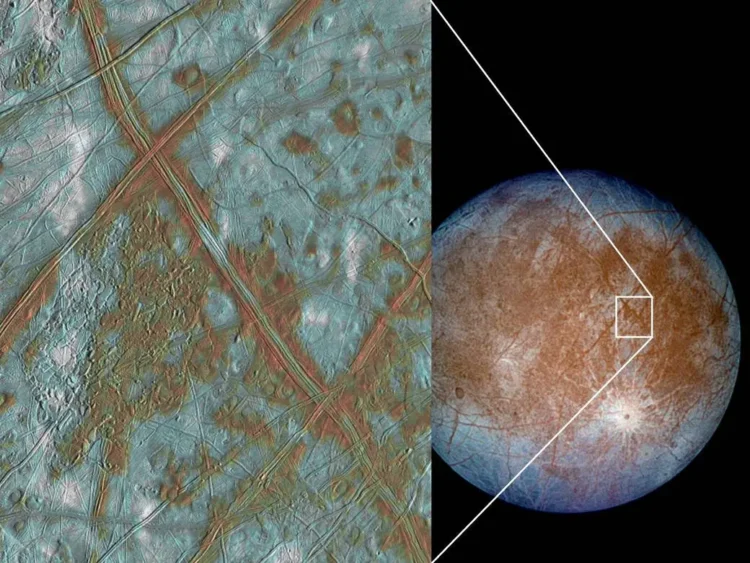The Europa Clipper spacecraft, scheduled to launch next month, aims to explore Jupiter’s enigmatic moon Europa, a world that has captivated scientists and space enthusiasts alike with its potential to harbor life beyond Earth.
A Frozen World with Hidden Depths
Europa, slightly smaller than Earth’s moon, has long been a subject of fascination for astronomers and planetary scientists. Discovered by Galileo Galilei in 1610, this icy world has revealed tantalizing clues about its nature over the centuries. But it wasn’t until NASA’s Galileo mission in the 1990s that Europa’s true potential was unveiled.
According to Dr. Robert Pappalardo, Europa Clipper’s project scientist at NASA’s Jet Propulsion Laboratory (JPL), “We’re not a life search mission. We’re a habitability mission.” However, he adds that finding a hint of life is “not out of the question.”
What makes Europa so intriguing is what lies beneath its icy surface. Scientists believe that under a 15 to 25-kilometer thick ice shell, there exists a vast saltwater ocean, potentially as deep as 150 kilometers. This hidden ocean, warmed by tidal forces from Jupiter’s immense gravitational pull, could provide conditions similar to those that support life on Earth.
The Mission: A Technological Marvel
The Europa Clipper mission, with a price tag of $5 billion, represents NASA’s most expensive planetary science venture since the Cassini-Huygens mission to Saturn in the late 1990s. The spacecraft, equipped with nine cutting-edge science instruments, will perform nearly 50 close flybys of Europa, some as low as 25 kilometers above the surface.
Dr. Margaret Kivelson, a space physicist at the University of California, Los Angeles and member of the Clipper mission team, emphasizes the groundbreaking nature of this endeavor: “We’re going to do something we’ve never done before.”
The mission faces significant challenges, particularly the harsh radiation environment around Jupiter. JPL Director Laurie Leshin describes it as “the nastiest environment in the Solar System,” noting that “every time we fly by Europa, it’s like getting 100,000 chest x-rays.”
According to Science, to protect against this intense radiation, the spacecraft’s sensitive electronics are housed in a specialized vault made of radiation-blocking alloys. In a poetic touch, the vault is capped with a tantalum metal plate etched with a poem by U.S. Poet Laureate Ada Limón, connecting the wonder of Earth’s oceans with Europa’s hidden sea.
Unraveling Europa’s Mysteries
The Europa Clipper’s suite of instruments is designed to peer beneath the icy surface and reveal the moon’s secrets. Key objectives include:
- Confirming the Ocean’s Existence: The spacecraft’s magnetometer will detect Europa’s magnetic field, providing definitive proof of the subsurface ocean and insights into its depth and salinity.
- Mapping the Surface: A dual-camera system will map almost all of Europa at a resolution five times better than previous missions, revealing details about its geology and potential cryovolcanic activity.
- Analyzing Ocean Chemistry: The Surface Dust Analyzer (SUDA) will capture and analyze ice particles ejected from Europa’s surface, providing clues about the ocean’s composition and potential habitability.
- Searching for Plumes: Multiple instruments will work in concert to search for and potentially sample water vapor plumes erupting from the surface, which could provide direct access to the subsurface ocean.
Implications for the Search for Life
If Europa Clipper confirms that Europa’s ocean is indeed habitable – or even more excitingly, if it finds signs of life – the implications would be profound. Such a discovery would dramatically expand our understanding of where life can exist in the universe.
Dr. Thomas Zurbuchen, a former NASA science chief now leading ETH Zürich, suggests that a positive finding would immediately lead to plans for “the next type of mission… to go find life.” This could involve a lander to directly sample Europa’s surface or even more ambitious concepts like a probe that could melt through the ice and explore the ocean directly.
Moreover, a habitable ocean on Europa would force scientists to reconsider the traditional definition of a star’s “habitable zone.” It would suggest that life could exist much farther from a star than previously thought, as long as there are mechanisms to maintain liquid water beneath an icy surface.
A New Chapter in Space Exploration
As the Europa Clipper prepares for its journey, the excitement in the scientific community is palpable. Dr. Leshin draws a parallel to Galileo’s initial discovery of Europa, noting how it changed our perception of our place in the universe. “This moon has already done that once,” she says. “Wouldn’t it be cool if it did it again… because of Clipper?”
The Europa Clipper mission represents a new frontier in our exploration of the solar system. By peering beneath the icy surface of this distant moon, we may not only unlock the secrets of Europa but also gain new insights into the potential for life throughout the cosmos. As humanity continues to push the boundaries of space exploration, the Europa Clipper stands as a testament to our enduring curiosity and our quest to understand our place in the universe.




